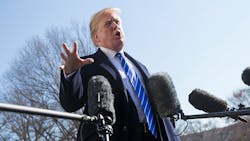If you think President Donald Trump’s trade agenda was busy in 2018, get ready for much more to come in the new year. The first quarter of 2019 will be pivotal, as the U.S. and China are trying to deescalate a trade war and Trump will have to decide whether to hit car imports with tariffs.
Here’s a list of some of the most important dates and deadlines for Trump’s trade agenda in coming days and months:
Jan. 1: America’s updated free-trade agreement with South Korea, which the nations’ two leaders signed in September, is due to enter into force.
Week of Jan. 7: A U.S. government delegation travels to Beijing for trade talks with Chinese officials, the first face-to-face encounter since Trump and Chinese President Xi Jinping agreed to a temporary truce on Dec. 1. If the two sides can’t reach a deal by March 1, Trump has pledged to boost tariffs on $200 billion of Chinese goods to 25% from 10%.
Week of Jan. 7: European Union Trade Commissioner Cecilia Malmstrom and U.S. Trade Representative Robert Lighthizer are scheduled to meet as part of ongoing negotiations, a person familiar with the planning said. The White House hasn’t published its formal objectives for trade negotiations, but the two sides have been meeting informally for months.
Jan. 10: Deadline for businesses to submit feedback to the Trump administration on its strategy to tighten restrictions on high-tech American exports such as artificial-intelligence components, microprocessors and robotics. It could take the White House several months to draw up its final plans, former government officials said.
Jan. 21: Formal talks to negotiate the U.S.-Japan Trade Agreement could start. Lighthizer’s office on Dec. 21 posted its negotiating objectives, which entail tackling Japan’s “multiple tariff and non-tariff barriers” and reducing the trade deficit.
Feb. 17: Deadline for the Commerce Department to publish a report on the national-security implications of auto imports that could justify tariffs on foreign cars. Commerce issued similar reports on steel and aluminum in 2018 that prompted Trump to impose tariffs on the metals. The department is due to submit another national-security report on the effects of uranium imports by mid-April. If Commerce takes until Feb. 17 to submit the auto report to the president, Trump has until May 18 to make a decision on tariffs.
First half of 2019: Congress may hold an up-or-down vote for the U.S.-Mexico-Canada Agreement, which would replace NAFTA. Senate Majority Leader Mitch McConnell has said a vote is high on the agenda for the new year, though multiple Democratic lawmakers argue the administration needs to go back to Mexico and Canada to negotiate stronger labor and enforcement provisions. Those demands could significantly delay the vote.
By Jenny Leonard
About the Author
Bloomberg
Licensed content from Bloomberg, copyright 2016.
